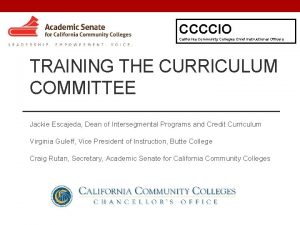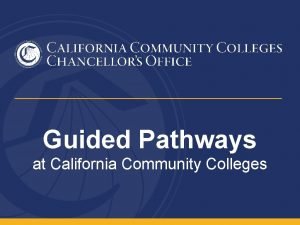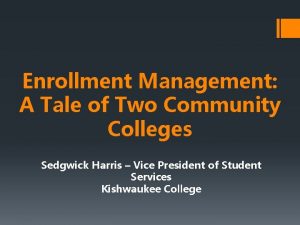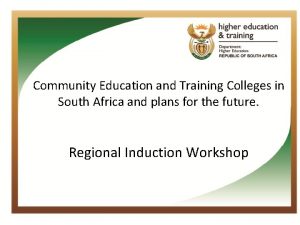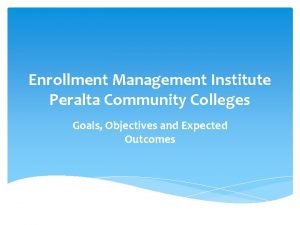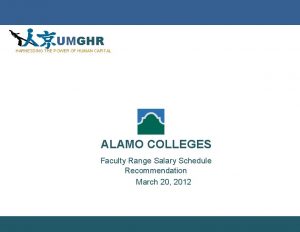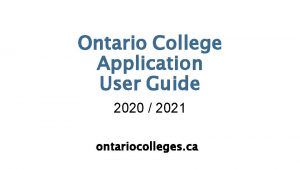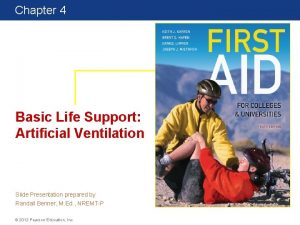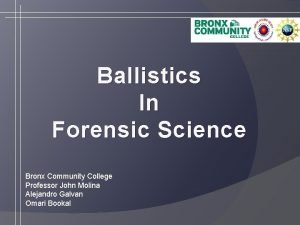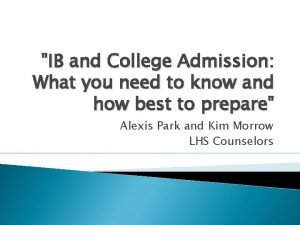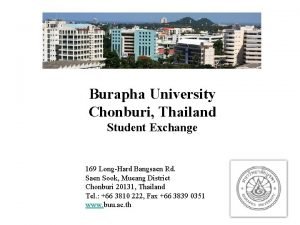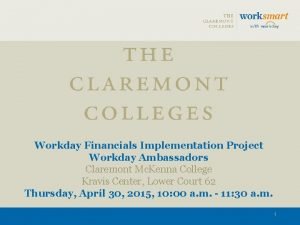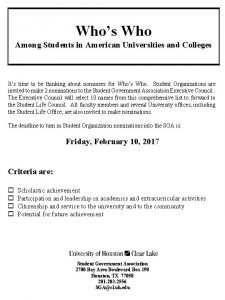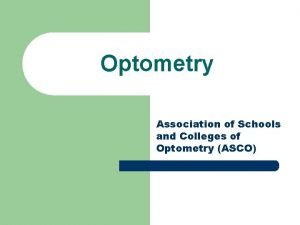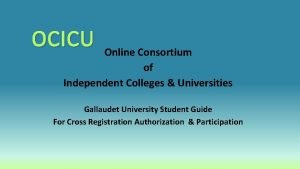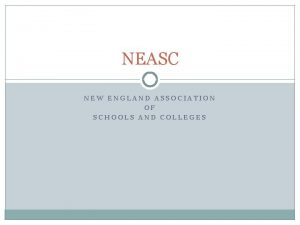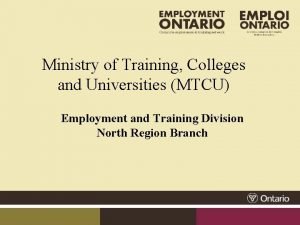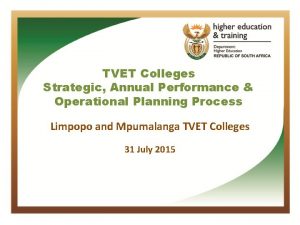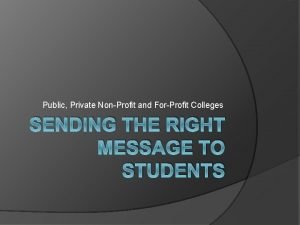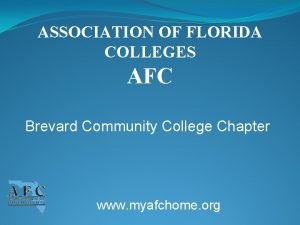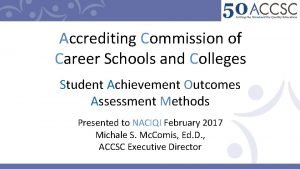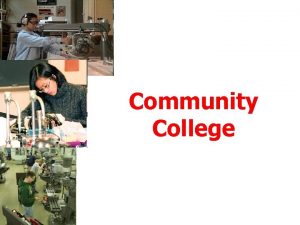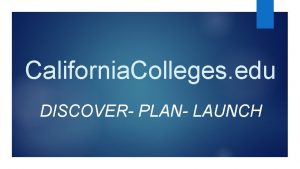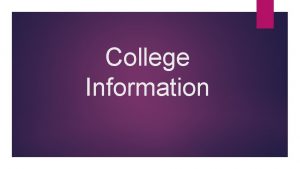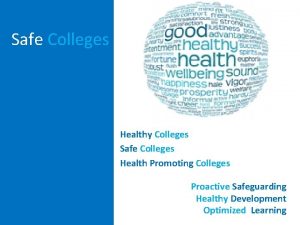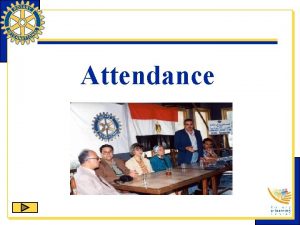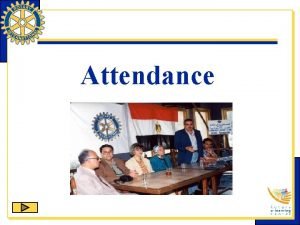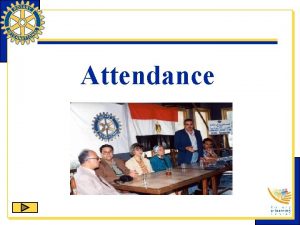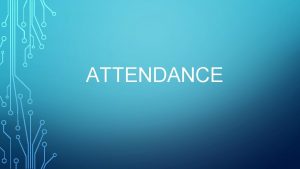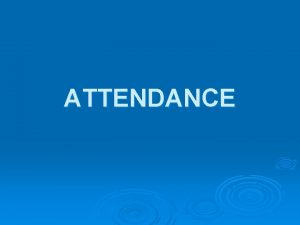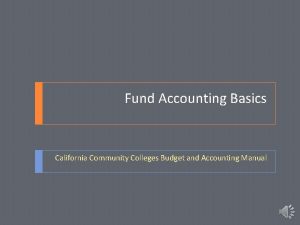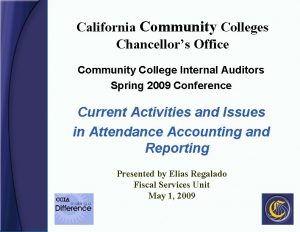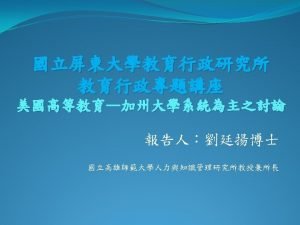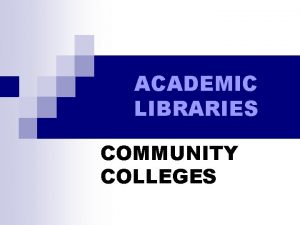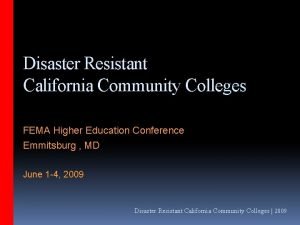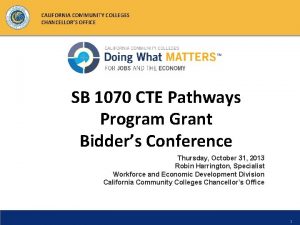Attendance Accounting for the California Community Colleges The















































- Slides: 47

Attendance Accounting for the California Community Colleges The Magical and Sometimes Mysterious CCFS-320 Report CACCRAO Conference April 24 -27, 2011 John Mullen, Senior Consultant Strata Information Group

Attendance Accounting for the California Community Colleges Academic Calendar n Census Dates n Open Enrollment Requirement n Apprenticeship Classes n Distance Education n Course Repetition n Residency Requirements n

Q: How is Apportionment Revenue allocated? A: On the basis of Full-time Equivalent Students (FTES) in attendance, as reported to the CCC System Office on the CCFS-320 Report three times each year.

Full-Time Equivalent Student (FTES) 1 FTES = 1 student 15 hours per week 2 semesters of 17. 5 weeks (3 quarters of 11. 67 weeks) = 525 contact hours

Program Funding Based on FTES n Lottery Revenue n Basic Skills Education n Instructional Equipment n Library Materials n Numerous State-funded categorical programs

Attendance Accounting for the California Community Colleges Sources of Authority n California Legislature Education Code n Board of Governors of the California Community Colleges Title 5 of the California Code of Regulations

Full-Time Equivalent Student (FTES) Reporting n n CCFS-320 u Includes Flex Calendar Adjustment u Center FTES u CDCP Noncredit FTES CCFS-321 (Apprenticeship)

Full-Time Equivalent Student (FTES) Reporting Periods First Period: n Second Period: n Third Period: n Reports due: July 1 – December 31 January 1 – April 15 April 16 – June 30 January 15 April 20 July 15

Full-Time Equivalent Student (FTES) Reporting Categories Students who are California residents n Students who are not residents of California n Students enrolled in credit courses n Students enrolled in specified noncredit courses n

Full-Time Equivalent Student (FTES) Reporting Clock hour n Class hour n Passing time/break n Partial class hour n Multiple hour class n

Clock Hour A 60 -minute time frame that may begin at any time. n Examples: 0800 to 0900 0810 to 0910 0820 to 0920 n

Class Hour A period of not less than 50 minutes of scheduled instruction or examination n There can be only one “class hour” in each “clock hour, ” except as provided for multiple hour classes. n A “class hour” is commonly called a “contact hour” or “Student Contact Hour. ” n

Passing Time/Break Each clock hour is composed of one class hour segment and a segment referred to as “passing time” or a “break. ” n No additional attendance may be claimed for this 10 -minute segment, except for multiple-hour classes. n

Partial Class Hour n The fractional part of a class hour at the end of a class scheduled for more than one clock hour

Multiple Hour Class Each 50 minutes exclusive of breaks is a class hour. n A partial class hour beyond the last full clock hour is counted from the 51 st minute of the last full clock hour. n

Multiple Hour Class No break is allowed in the last full clock hour or the partial class hour. n The divisor for this partial class hour is 50. n The total class hours cannot exceed the clock hours. n

Calculate the contact hours: Class meets from n 0900 to 0950 n 0900 to 1005 n 0900 to 1050 n 0900 to 1105 n 0900 to 1130 Contact hours: n 1. 0 n 1. 3 n 2. 0 n 2. 3 n 2. 8

Attendance Accounting Methods Weekly Student Contact Hour n Daily Student Contact Hour n Actual Hours of Attendance (Positive Attendance) n Alternative Attendance Accounting Method (Independent Study/Work Experience) n Noncredit Distance Education n

Weekly Student Contact Hour Primary terms only n Course coterminous with the primary term n Same number of days each week n Same number of hours each day n Same number of hours each week including TBA n

Census Week The week nearest to 20% of the number of weeks in the primary term n Census date is Monday of census week n If that Monday is a holiday, census date is the following day n

Term Length Multiplier n Number of weeks in primary term with at least three days of instruction and/or examination n Maximum TLM: 17. 5 for semesters 11. 67 for quarters

FTES Calculation (WSCH) n Multiply Census Week WSCH by the TLM and divide by 525 (CWSCH x TLM) / 525

Daily Student Contact Hour Course meets five or more days n Meets same number of hours on each scheduled day n NOT coterminous with primary term n

Census Day The day nearest 20% of the number of days the course is scheduled to meet n When the census day falls on the first day, census is taken on the second day. n

Course Length Multiplier n Number of days the course is scheduled to meet (CLM)

FTES Calculation (DSCH) n Multiply Census Day DSCH by the Course Length Multiplier and divide by 525 (CDSCH x CLM) / 525

Positive Attendance Based on actual count of enrolled students present at each class meeting n Courses meeting fewer than five days n Courses irregularly scheduled with respect to number of days per week or number of hours on scheduled days n All noncredit courses n

FTES Calculation (PA) n Divide total hours of actual attendance by 525 PAH / 525

Alternative Attendance Accounting Method (Independent Study / Work Experience) n WSCH method for courses coterminous with primary term n DSCH method for all other courses

Alternative Attendance Accounting Method (Independent Study / Work Experience) n One weekly student contact hour is counted for each unit of credit for which the student is enrolled as of the census date or day. n Lab hours can be added to the contact hours derived from each unit of credit

FTES Calculation (ISWE) n Multiply number of students enrolled as of census by the number of “weekly contact hours”; multiply by the term length multiplier; divide by 525. (# Students x “WCH” x TLM) / 525

Distance Education (Credit) Until 2002, all distance education courses had to be assigned to the Independent Study/Work Experience attendance accounting method. n Current regulations allow any appropriate accounting method to be used for distance education courses. n

Noncredit Distance Education Calculate the sum of the total hours of instruction or programming, plus hours expected for out-of-class work, plus hours of instructor contact. n Divide that sum by 54, and multiply by the number of students enrolled as of census day, and multiply by 17. 5. The result is the number of student contact hours. n

Noncredit Distance Education Report the number of student contact hours as of two census dates. n First census date is at the 20% point of the class. n Second census date is at the 60% point of the class. n

FTES Calculation (NCDE) n Compute the average of the student contact hours as of the two census dates and divide by 525. [0. 5 x (SCH 1 + SCH 2)] / 525

FTES Reporting Periods n Attendance for weekly and daily census sections is reported in the period in which the census date falls. n Attendance for positive attendance sections is reported in the period in which the last class meeting occurs. n Exception: Attendance for daily census sections with census date before July 1 and ending date after July 1 may be reported in either fiscal year.

CCFS-321 - Apprenticeship No FTES is calculated n Report actual hours of attendance n Residents and nonresidents together n Estimate annual total at P 1 n Revise that estimate at P 2 n Report actual annual hours by July 15 n

Annualizers Used to estimate annual FTES at P 1 and P 2 n A separate annualizer is used for each attendance method at each reporting period. n P 1 report is due in Sacramento on January 15. n P 2 report is due on April 20. n Annual report is due on July 15. n

Annualizers – Example n Calendar has two primary terms n All fall semester WSCH reported in P 1 n Attendance essentially equal each semester n WSCH annualizer at P 1 would be 2. 0

CCFS-320 Flexible Calendar Units of FTES other than WSCH are adjusted by a factor to provide same FTES as would have been generated by regular instruction instead of flex time activities. n Annual reports of flex hours and total contact hours by attendance method are reported at P 1, P 2 and by July 15. n

Title 5 Guidelines – Curriculum and Instruction n http: //www. cccco. edu/System. Office/Divisio ns/Academic. Affairs/Title 5 Guidelines/tabid/ 1330/Default. aspx u u Course repetition Withdrawal limitations Distance education Tutoring

Legal Advisories n Directory of Advisories http: //www. cccco. edu/System. Office/Divisions/Le gal/Legal. Advisories/tabid/410/Default. aspx n Advisory on Concurrent Enrollment http: //www. cccco. edu/Portals/4/Legal/advisories/a ttachments/Advisory_05 -01. pdf

FTES Calculation n Primer on Computing FTES http: //www. cccco. edu/Portals/4/CFFP/Fiscal/ Allocations/app/PRIMER_ON_COMPUTIN G_FTES. pdf

Attendance Accounting Manual n When in doubt, check this valuable resource n Education Code and Title 5 references included n Available online at http: //www. cccco. edu/System. Office/Divisions/Finance. Facilities/Fi scal. Services/Allocations. Section/Student. Attendance. Accounting. Man ual/tabid/833/Default. aspx

SAAM Addendum n Compressed Calendar and Course Scheduling http: //www. cccco. edu/Portals/4/CFFP/Fiscal/ Allocations/manuals/SAAM_Compressed_Ca lendar_and_Course_Scheduling_Addendum_ FINAL_9 -18 -08. pdf

CACCRAO California Association of Community College Registrars and Admissions Officers n Annual conferences n Regional staff development workshops n Web site: http: //www. caccrao. org n Helpful colleagues n

Questions and Answers n Contact information: John Mullen Strata Information Group Phone: 650. 533. 6850 mullen@sigcorp. com
 Ccccio website
Ccccio website California community college chief instructional officers
California community college chief instructional officers Cccco guided pathways
Cccco guided pathways Community colleges
Community colleges Community education and training colleges
Community education and training colleges Washington state board for community and technical colleges
Washington state board for community and technical colleges Community colleges
Community colleges Ciip canada
Ciip canada Ccap california community college
Ccap california community college Alamo colleges salary schedule
Alamo colleges salary schedule World federation of colleges and polytechnics
World federation of colleges and polytechnics Ontariocolleges
Ontariocolleges Alamo colleges 1098 t
Alamo colleges 1098 t Pearson
Pearson Brevet des colleges
Brevet des colleges Colleges for forensic ballistics
Colleges for forensic ballistics Styria colleges and universities
Styria colleges and universities Ufa state petroleum technical university
Ufa state petroleum technical university Columbia university ib requirements
Columbia university ib requirements Restoration movement colleges
Restoration movement colleges Chelyabinsk colleges and universities
Chelyabinsk colleges and universities Chon buri colleges and universities
Chon buri colleges and universities Yaroslavl colleges and universities
Yaroslavl colleges and universities Claremont workday
Claremont workday Who's who among american college students
Who's who among american college students Association of schools and colleges of optometry
Association of schools and colleges of optometry Ocicu courses
Ocicu courses Jelaskan kegiatan menulis di perguruan tinggi?
Jelaskan kegiatan menulis di perguruan tinggi? Different types of colleges
Different types of colleges Northern ireland colleges
Northern ireland colleges Sakai claremont colleges
Sakai claremont colleges New england association of colleges and schools
New england association of colleges and schools Mtcu ontario
Mtcu ontario Tvet colleges limpopo
Tvet colleges limpopo Forprofit colleges
Forprofit colleges Association of florida colleges
Association of florida colleges Accrediting commission of career schools and colleges
Accrediting commission of career schools and colleges Fspos
Fspos Typiska novell drag
Typiska novell drag Nationell inriktning för artificiell intelligens
Nationell inriktning för artificiell intelligens Vad står k.r.å.k.a.n för
Vad står k.r.å.k.a.n för Varför kallas perioden 1918-1939 för mellankrigstiden?
Varför kallas perioden 1918-1939 för mellankrigstiden? En lathund för arbete med kontinuitetshantering
En lathund för arbete med kontinuitetshantering Adressändring ideell förening
Adressändring ideell förening Personlig tidbok för yrkesförare
Personlig tidbok för yrkesförare Anatomi organ reproduksi
Anatomi organ reproduksi Vad är densitet
Vad är densitet Datorkunskap för nybörjare
Datorkunskap för nybörjare
